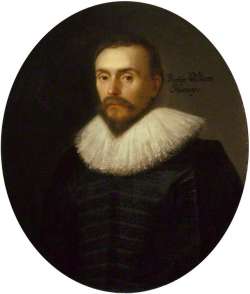William Harvey

William Harvey
- Born
- 1 April 1578
- Died
- 3 June 1657 (age 79)
William Harvey was the first person to describe in detail the circulation of blood around the body. He left a legacy of the importance of using experiments to prove or disprove a belief.
After graduating from Cambridge with a Bachelor of Arts, Harvey travelled to Italy, and studied at the University of Padua in 1599, when Galileo Galilei (the hugely influential Italian astronomer, physicist and philosopher) was a tutor there. He was taught by the surgeon and scientist Hieronymus Fabricius, who had recognised that veins in the human body had one-way valves. At the age of twenty-four, Harvey graduated as a Doctor of Medicine, and returned to England where he received another Doctor of Medicine from Cambridge.
In 1607, he was elected a Fellow of the Royal College of Physicians, and accepted a post at St Bartholomew’s Hospital in London (now Bart’s), which he held for most of his life. In 1615 he was appointed as a Lumleian lecturer. This involved carrying out a number of lectures over a seven-year period, to spread general knowledge of anatomy. The notes which he used for these lectures are preserved in the British Museum. It was during these lectures that he first publicly stated his theory of how blood circulated.
In 1618 he was appointed as physician to King James I, and later to King Charles I. Accompanying Charles on hunting trips gave him access to deer carcasses which he used for many observations.
Harvey built on Fabricius’s recognition of the human body’s one-way valves by establishing their role in the circulation of blood. He estimated the capacity of the heart, how much blood was expelled by each pump, and how many times the heart pumped in half an hour. His calculations showed that the accepted belief that the liver was the origin of venous (deoxygenated) blood, as proposed by Galen, was incorrect.
Harvey experimented on a number of snakes and fish. When he tied the veins, the heart emptied, and when he tied the arteries, it filled up. These experiments were later carried out on people.
He published his treatise on the circulation of the blood in Frankfurt in 1628, An Anatomical Exercise Concerning the Motion of the Heart and of the Blood in Animals. He carried out a detailed analysis of the heart and arteries, and wrote about the way that blood was passed through the heart from the veins to the arteries. He said that blood flowed continuously in one direction through the body, and that the transformation of blood from veins to the arteries took place in the lungs. He also theorised about the existence of capillaries, but without the correct instruments being available at the time, was unable to prove this.



